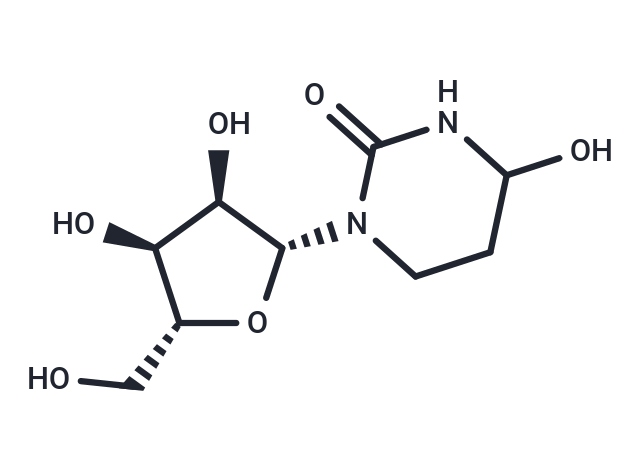Shopping Cart
- Remove All
 Your shopping cart is currently empty
Your shopping cart is currently empty

Tetrahydrouridine (NSC-112907; THU) is a multidrug resistance modulator. It can be used in cancer treatment to make tumor cells more sensitive to radiation therapy. THU is a competitive cytidine deaminase(CDA) inhibitor that inhibits deamination in the catabolism of cytotoxic deoxycytidine analogs such as ara-C and Gemcitabine.

| Pack Size | Price | Availability | Quantity |
|---|---|---|---|
| 25 mg | $1,520 | 4-6 weeks | |
| 50 mg | $1,980 | 4-6 weeks | |
| 100 mg | $2,500 | 4-6 weeks |
| Description | Tetrahydrouridine (NSC-112907; THU) is a multidrug resistance modulator. It can be used in cancer treatment to make tumor cells more sensitive to radiation therapy. THU is a competitive cytidine deaminase(CDA) inhibitor that inhibits deamination in the catabolism of cytotoxic deoxycytidine analogs such as ara-C and Gemcitabine. |
| In vitro | To test how Tetrahydrouridine affects the Gemcitabine-mediated anti-neoplastic effect on pancreatic and lung carcinoma cells, a combination therapy is performed. As expected, high CDA expression in BxPC-3 and H441 results in improved Gemcitabine sensitivity after a 100 μM Tetrahydrouridine treatment. The sensitivity of BxPC-3 and H441 cell lines increases by as much as approximately 2.1 and 4.4 fold respectively. On the other hand, MIAPaCa-2 and H1299 cells unexpectedly become more sensitive to Gemcitabine with low CDA expression. MIAPaCa-2 and H1299 cells show a change in an IC50?of 2.2 and 2.3 fold respectively. However, Panc-1 and H322 cells do not show significant changes in drug sensitivity. These data suggested that Tetrahydrouridine can sensitize some pancreatic and lung carcinoma cells to Gemcitabine-induced cell death regardless of CDA expression levels. Tetrahydrouridine inhibits S-phase without apoptosis. |
| In vivo | Tetrahydrouridine (167 mg/kg) followed by DAC (1.0 mg/kg) results in death in one male and eight females. Animals surviving to scheduled termination are generally asymptomatic with no treatment related effects observed in body weights, food consumption, clinical chemistry and urinalysis for a treatment up to 1.0 mg/kg DAC in combination with 167 mg/kg Tetrahydrouridine in animals. |
| Alias | NSC-112907, NSC112907, NSC 112907 |
| Molecular Weight | 248.23 |
| Formula | C9H16N2O6 |
| Cas No. | 18771-50-1 |
| Relative Density. | 1.622g/cm3 |
| Storage | Powder: -20°C for 3 years | In solvent: -80°C for 1 year | Shipping with blue ice. | |||||||||||||||||||||||||
| Solubility Information | DMSO: 10 mg/mL (40.29 mM), Sonication is recommended. H2O: Insoluble | |||||||||||||||||||||||||
Solution Preparation Table | ||||||||||||||||||||||||||
DMSO
| ||||||||||||||||||||||||||

Copyright © 2015-2025 TargetMol Chemicals Inc. All Rights Reserved.